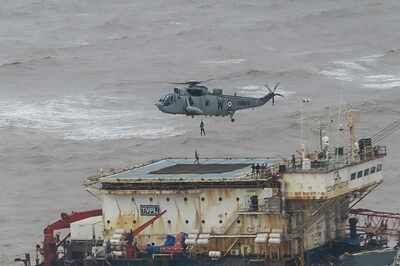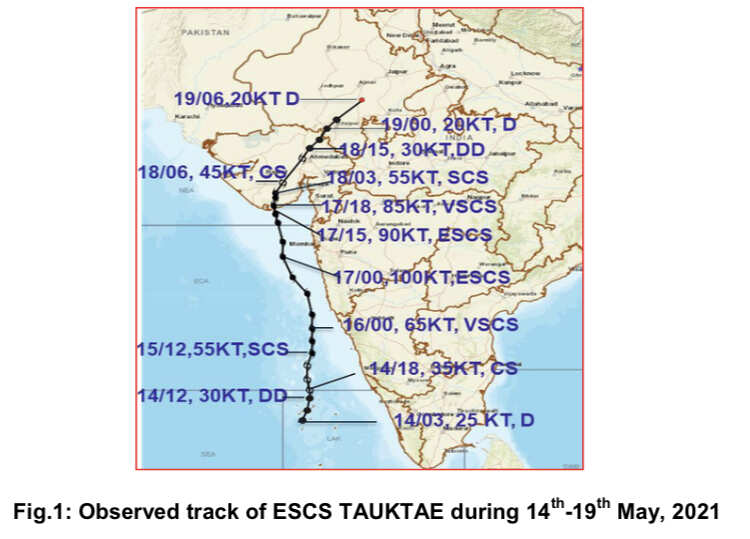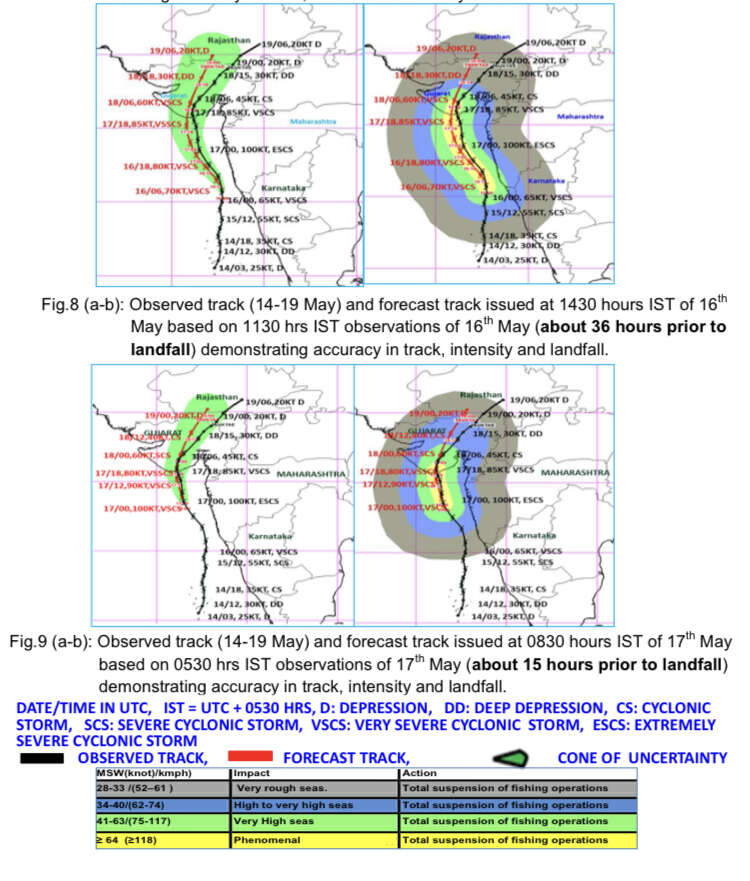Top Searches
- News
- India News
- Warning issued with sufficient lead period and reasonably higher forecast accuracy: Report on cyclone Tauktae
Warning issued with sufficient lead period and reasonably higher forecast accuracy: Report on cyclone Tauktae

NEW DELHI: Amid certain questions over the prediction of the cyclone Tauktae in the wake of the ONGC vessel tragedy, the ministry of earth sciences (MoES) on Thursday released a factsheet on the cyclone that hit the western coast last month, saying “all kind of adverse weather associated with these systems including heavy rainfall, strong wind and storm surge were well predicted by India Meteorological Department (IMD) with sufficient lead period.”
Giving the national weather forecaster a clean chit, the report noted that the “bulletins for maritime interest” were issued by area cyclone warning centres of IMD at Mumbai, Chennai and cyclone warning centres at Thiruvananthapuram and Ahmedabad to all stakeholders including coastal and high sea shipping community well in advance.
Underlining that the track, landfall and intensity forecast accuracy was reasonably higher than that of the previous recurving cyclones, the report carrying all technical details on the ‘extremely severe cyclonic storm’ Tauktae said that the warnings and updates were being constantly issued since May 11 onwards -- six days prior to landfall over Gujarat coast on May 17 late evening.


Issuing its “extended range outlook”, the IMD had on May 13 indicated that the system would move towards Gujarat coast and would “impact the areas including southeast, east-central & northeast Arabian Sea” and areas along & off Kerala, Karnataka, Goa, Maharashtra and Gujarat coasts.
“Accordingly, a likely impact was also issued in the extended range outlook for fishermen, ships and ports along the west coast of India,” said the report, giving a clear signal that the authorities had enough window to act on advance warnings. Though the report has not named ONGC as one of the recipients of those constant warnings on the cyclone’s track and intensity, officials in the MoES said all information and associated weather impacts' warnings had been shared with all agencies including the oil PSU.
Four vessels that the ONGC put into service off Mumbai coast went adrift in the high seas due to impact of the cyclone Tauktae in the early hours of May 17, causing loss of many lives. The incident had led to questions and counter-questions over the quality of prediction and required actions on the warnings.
The report also carried details on the ‘very severe cyclonic storm’ Yaas that hit eastern coast (Odisha and West Bengal) on May 26. It said that the track and landfall point & time forecast errors were exceptionally less as compared to the ‘long period average’ errors and the landfall point and time forecast errors were almost zero up to a lead period of 48 hours.
With the track length of 1,100 km, the Yaas had affected relatively less areas as compared to Tauktae, causing adverse weather over Andaman & Nicobar Islands, Odisha & West Bengal (till May 26) and Jharkhand, Bihar and east Uttar Pradesh after landfall.
Giving the national weather forecaster a clean chit, the report noted that the “bulletins for maritime interest” were issued by area cyclone warning centres of IMD at Mumbai, Chennai and cyclone warning centres at Thiruvananthapuram and Ahmedabad to all stakeholders including coastal and high sea shipping community well in advance.
Underlining that the track, landfall and intensity forecast accuracy was reasonably higher than that of the previous recurving cyclones, the report carrying all technical details on the ‘extremely severe cyclonic storm’ Tauktae said that the warnings and updates were being constantly issued since May 11 onwards -- six days prior to landfall over Gujarat coast on May 17 late evening.


Issuing its “extended range outlook”, the IMD had on May 13 indicated that the system would move towards Gujarat coast and would “impact the areas including southeast, east-central & northeast Arabian Sea” and areas along & off Kerala, Karnataka, Goa, Maharashtra and Gujarat coasts.
“Accordingly, a likely impact was also issued in the extended range outlook for fishermen, ships and ports along the west coast of India,” said the report, giving a clear signal that the authorities had enough window to act on advance warnings. Though the report has not named ONGC as one of the recipients of those constant warnings on the cyclone’s track and intensity, officials in the MoES said all information and associated weather impacts' warnings had been shared with all agencies including the oil PSU.
Four vessels that the ONGC put into service off Mumbai coast went adrift in the high seas due to impact of the cyclone Tauktae in the early hours of May 17, causing loss of many lives. The incident had led to questions and counter-questions over the quality of prediction and required actions on the warnings.
The report also carried details on the ‘very severe cyclonic storm’ Yaas that hit eastern coast (Odisha and West Bengal) on May 26. It said that the track and landfall point & time forecast errors were exceptionally less as compared to the ‘long period average’ errors and the landfall point and time forecast errors were almost zero up to a lead period of 48 hours.
With the track length of 1,100 km, the Yaas had affected relatively less areas as compared to Tauktae, causing adverse weather over Andaman & Nicobar Islands, Odisha & West Bengal (till May 26) and Jharkhand, Bihar and east Uttar Pradesh after landfall.
FacebookTwitterLinkedinEMail
Start a Conversation
end of article
Quick Links
Coronavirus in MumbaiFarm bill 2020Farmers protestCoronavirus in DelhiCoronavirus in BangaloreCoronavirus symptomsCoronavirus in IndiaWest Bengal elections 2021Coronavirus NewsSolar EclipseNPRWhat is NRCCAB BillCAB and NRCAssam election 2021Podcast newsLok SabhaTamil Nadu Election 2021CongressBJP newsKerala Elections 2021Indian ArmyISRO newsSupreme Court
